Disassembly
To disassemble the rear disc brake caliper, perform the following steps in sequence.
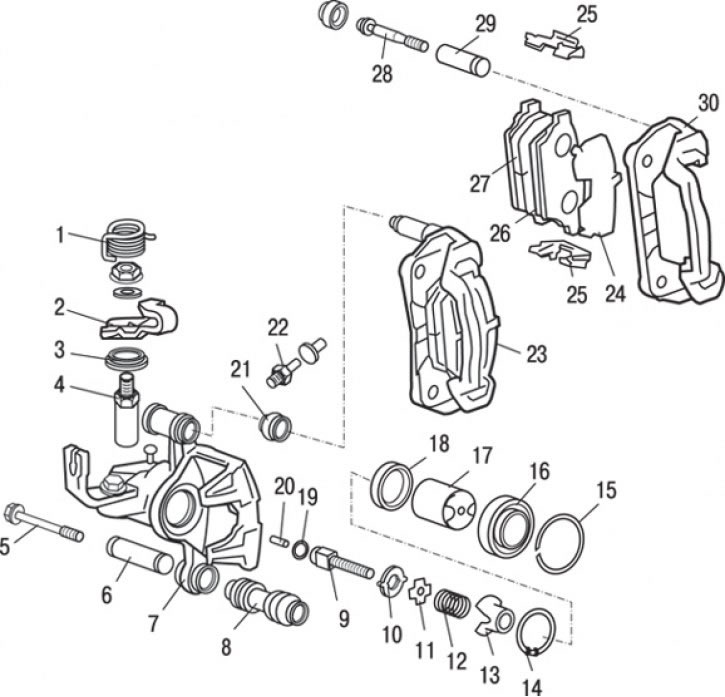
Pic. 14.38. Rear disc brake caliper: 1 - return spring; 2 – parking brake lever; 3 – anther of the lever; 4 - stem lever; 5 - lower guide pin (26 Nm); 6 - bushing of the lower guide pin; 7 - caliper body; 8 - anther of the lower guide pin; 9 - control rod; 10 - limiter; 11 - limiter plate; 12 - return spring; 13 - spring housing; 14 - retaining ring; 15 – piston anther ring; 16 - piston boot; 17 - piston assembly; 18 - piston sealing ring; 19 - ring gasket; 20 - connecting rod; 21 - anther of the upper guide pin; 22 - fitting for pumping (7.8 Nm); 23 - caliper bracket (complete with brake pads, pad guides and gasket); 24 - outer gasket; 25 - guide pads; 26 - brake shoe assembly; 27 - brake shoe with wear indicator as an assembly; 28 - upper guide pin (26 Nm); 29 - bushing of the upper guide pin; 30 - caliper bracket
1. Unscrew the lower guide pin 5 (pic. 14.38).
2. Lift up the caliper bracket 23 (complete with brake pads, pad guides and gasket).
3. Remove the sleeve 6 of the lower guide pin.
4. Remove boot 8 of the lower guide pin.
5. Remove the boot 21 of the upper guide pin.
6. Remove the ring 15 of the piston boot.
7. Remove the boot 16 of the piston.
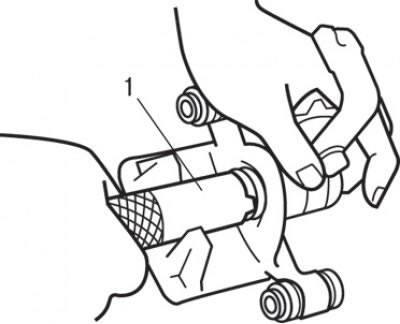
Pic. 14.39. Using the special tool MB990652 (1) for unscrewing the piston from the caliper body
8. Using a special tool, unscrew the piston from the caliper body (pic. 14.39).
9. Remove the O-ring with your finger.
Attention! To prevent damage to the inner surface of the working brake cylinder, do not use a flathead screwdriver or other tool.
10. Flush piston and cylinder surfaces with trichlorethylene, alcohol, or recommended DOT 3 or DOT 4 brake fluid.
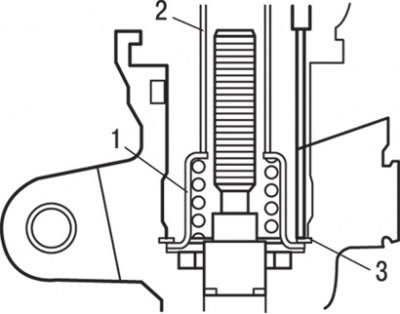
Pic. 14.40. Removing the retaining ring: 1 - spring housing; 2 - steel tube; 3 - snap ring
11. Using a steel tube with a diameter of 19 mm, press the spring case against the caliper body as shown in fig. 14.40, and using a special tool, remove the retaining ring.
12. Remove the spring housing 13 (see fig. 14.38).
13. Remove return spring 12.
14. Remove the plate 11 of the limiter.
15. Remove the limiter 10.
16. Remove control rod 9.
17. Remove connecting rod 20.
18. Remove the O-ring 19.
19. Remove the lever 4 rods.
20. Remove anther 3 levers.
21. Remove the parking brake lever 2.
22. Remove return spring 1.
23. Unscrew the fitting 22 for pumping.
24. Remove the case 7 of a support.
25. Remove outer gasket 24.
26. Remove the brake shoe 26 as an assembly.
27. Remove brake shoe 27 with wear indicator assembly.
28. Remove the shoe guide 25.
29. Unscrew the top guide pin 28.
30. Remove the bushing 29 of the upper guide pin.
31. Remove bracket 30 of the caliper.
Examination
1. Check the brake cylinder for wear, damage or rust.
2. Check the piston surface for wear, damage or rust.
3. Check the caliper body and bushings for wear.
4. Check the brake pads for damage or oiling, and the metal bases of the pads for damage.
Assembly
Assembly is carried out in the reverse order of disassembly, taking into account the following
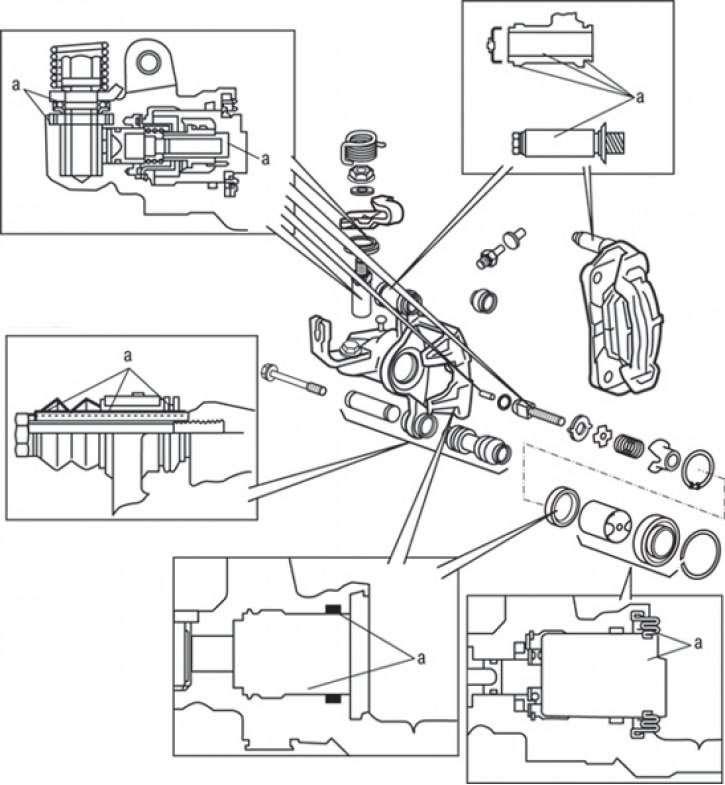
Pic. 14.41. Places (A) applying grease from the repair kit to the parts of the caliper
1. When assembling the rear disc brake caliper, apply the grease from the repair kit to the surfaces shown in fig. 14.41.
Attention! The sealing ring and the piston boot are coated with a special grease, so this grease must not be removed.
2. Using a steel tube with a diameter of about 19 mm and the special tool that was used during disassembly, install the retaining ring in place.
Attention! Install the retaining ring with the bleeder port open.
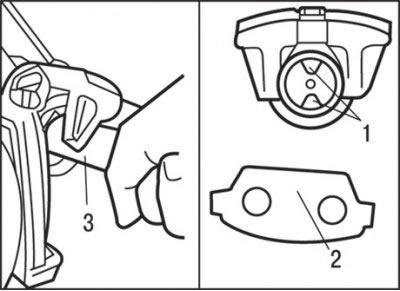
Pic. 14.42. Using the special tool to install the piston assembly: 1 - limiter grooves; 2 - ledge; 3 - special tool МВ990652
3. Using special tool MB990652 3 (pic. 14.42), install the piston into the caliper body.
Attention! Position the grooves as shown in Fig. pic. 14.41.
The lugs on the back of the brake pads must be in the piston grooves.
